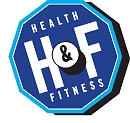
Staying active is challenging in many ways, but for senior citizens, getting older compounds the predicament. It takes longer to recover from an illness; soreness and stiffness are a daily companion; and getting injured is a much more serious concern.
But for some local seniors, the prospect of staying active isn’t a challenging one at all—it’s just a part of their lifestyle. Daily activities include a variety of low-impact exercises at little to no cost that get them out of the house and moving.
Movement is key. “You don’t move it, you lose it,” the saying goes, and seniors throughout the Central Coast have found their own personal habits and activities to keep them moving, motivated, and healthy well into their 80s.
Clubhouse for big kids: The SLO Senior Center offers a chance to get moving and stay connected
They all sit in a circle, chanting and moving together. It’s not a spiritual gathering; it’s just a regular Thursday morning at the SLO Senior Citizens Center at Mitchell Park, where PJ Crawford leads the chair exercise group.
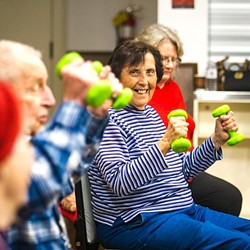
- PHOTO BY JAYSON MELLOM
- MOVING TOGETHER: Attendees of the SLO Senior Citizens Center’s chair exercise program get to sit, stretch, and exercise in a group. Socializing, singing, and laughter are all part of the program as well.
The attendees—who range in age from late 60s all the way to early 90s—are pumping colorful hand weights and balls in the air from seated positions. They also stand, stretch, and move in unison under Crawford’s playful and friendly direction.
“It’s not just exercising our bodies,” Crawford told New Times, “but exercising our minds, our hearts, and our souls.”
Crawford knows it’s just a simple exercise program, but the Senior Citizens Center is a special place, she explained.
Just a block off SLO’s iconic downtown, the center is a nexus for seniors who live in town or nearby, she said. Many seniors live alone, she explained, and so connecting socially while staying active is important.
Following the class that day, Crawford went to lunch with the group, just one example of the closeness and camaraderie they enjoy together.
“They’re all such good friends and they take such good care of each other. If we haven’t seen somebody for a while, somebody will call and say, ‘How are you?’ and let us know,” she said. “And even if someone ends up in a convalescent home, we know, and we call and see if they want company.”
One attendee, Jeanette Krystoff, makes it to almost every session of the chair exercise group, which meets on Tuesdays and Thursdays.
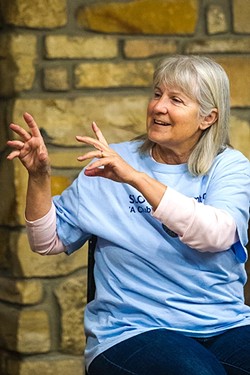
- PHOTO BY JAYSON MELLOM
- GIVING HER TIME: SLO Senior Citizens Center volunteer PJ Crawford leads the chair exercise program there, which meets twice a week on Tuesday and Thursday mornings.
Krystoff is in her early 80s and lives in Avila Beach, where she goes on walks most days. She said she doesn’t mind making the drive twice a week to attend the chair exercise group.
“It keeps me limber and from getting stiff. It takes away pain from arthritis and things like that,” she said. “It keeps you moving, and it’s social too, which I think is very good for people our age.”
“I have four friends that come here,” she added. “We all went to school together in San Luis all the way through high school.”
The dues to be a member of the club are inexpensive, only $12 a year, Krystoff said.
While she is a member specifically for the exercise program, she said, others are attracted to additional activities at the center.
“A lot of people come here and they don’t exercise,” she said, “but they play cards, do puzzles, and if you look at our monthly schedule you see all the things that go on.”
Also on the schedule is a monthly visit from a nurse with the Community Action Partnership of San Luis Obispo (CAPSLO), a nonprofit that provides support in housing, medical services, employment training, and other assistance for locals in need.
Visiting that same Thursday and screening attendees of the chair exercise program, RN Heather Murphy explained that CAPSLO provides health screenings at local senior centers and other community centers in SLO County.
“I believe that health care should be in community settings. It’s a completely different situation than going to a doctor,” Murphy said. “The fact that it’s not intimidating, we’ll take as much time to answer questions as you need, which is something that is missing in our health care system now. And it’s needed more and more in our health care system, that we have points of care outside the traditional doctor’s office.”
Members of the senior center, like Krystoff, get regular checkups from CAPSLO nurses like Murphy. They check blood sugar, blood pressure, and provide other screenings at no cost, Murphy said.
- JOIN THE CLUB: The SLO Senior Citizens Center is located at 1445 Santa Rosa St., SLO. More info: 781-7306 or slocity.org.
This gives seniors a more complete picture of their health, she explained, without an appointment at a doctor’s office, which can be costly. Screenings like those at the senior center aren’t meant to replace physician care, but supplement it, she said.
“I don’t think people fear getting old, I really think people fear getting sick, which doesn’t have to be a part of aging,” Murphy said. “Being able to ask questions and have access, hopefully we catch it before it becomes an illness. And for seniors, an illness can really bring them down.”
An important part of staving off illness in older age is exercise, Krystoff said.
Even when she falls ill with a cold, she still tries to do some kind of activity, Krystoff explained. Whether doing a bit of dancing in her living room or some chair exercises, it’s good to stay moving.
“People get discouraged, and they start putting on weight because they’re not moving,” Krystoff said. “Some people rise to the occasion and some don’t. You have a choice.”
The SLO Senior Citizens Center is designed to give local seniors myriad opportunities to stay active and social, explained Joan Drake, the board president for the center.
The center is sponsored by the SLO Parks and Recreation Department, but is an entirely volunteer-run organization. From Drake—who organizes goings on at the center—to Crawford in the chair program, everyone working at the center donates their time. The volunteers are all seniors themselves too, Drake explained, and they’re all needed to keep things running.
“We’re actually bursting at the seams,” Drake said. “We have almost 300 people who are members here, and sometimes it’s like musical chairs because we only have a certain number of rooms, and we’re trying to keep activities going constantly, and we have a small parking lot.”
The senior center doesn’t just serve as a hub for local seniors but for organizations that serve them as well. Senior center volunteer Kathleen Bellefontaine has a desk there, but she’s also the chair of the SLO County Commission on Aging.
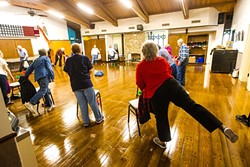
- PHOTO BY JAYSON MELLOM
- FITNESS AND FUN: The SLO Senior Citizens Center is a nexus for local seniors to congregate and enjoy fitness and leisure activities. The center also hosts health screenings provided by Community Action Partnership of San Luis Obispo (CAPSLO).
The commission advocates for the interests of SLO’s senior population to the SLO County Board of Supervisors, Bellefontaine explained, and brings broader issues to the board’s attention. One problem in particular is local access to health care for seniors, she said, especially the lack of specialists who live and practice in the area.
Many seniors have to travel hundreds of miles for the necessary care, she said.
“The commission, I think, is a good role model to solve problems, to let seniors be at the table where a lot of the youth are, and speak up and see how we can put our focus on something that is doable but will help all of us,” Bellefontaine said. “That’s what has allowed us, as a commission, to have more access to transportation that is affordable for seniors.”
The SLO Senior Citizens Center, at least, has basic medical screenings covered thanks to the help of CAPSLO, but also does plenty to keep local seniors healthy.
The center organizes “field trip” visits to local places, explained board President Drake. And the activities at the center include dancing, music, and even brain games designed to stimulate the memory and preserve the mind.
The pleasant chatter of its members buzzes through the senior center’s halls after the exercise class lets out. They’re moving, they’re active, but they’re also connecting with friends.
“It’s kind of like a home away from home,” Drake said. “We call it ‘the club house for big kids,’ that’s our motto.”
Out but in: Seniors don’t have to break the bank to stay fit in Santa Maria
It’s a slow day at the Santa Maria Town Center—the mall in the center of town—and shoppers stroll the wide-open halls at a leisurely pace. But two people stand out from the rest—they’re walking with determined quickness, passing the families and teenagers ambling between shops.
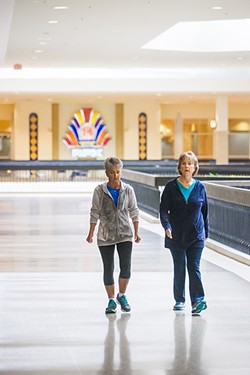
- PHOTO BY JAYSON MELLOM
- INDOOR ACTIVITY: Linda Schnell (left) and Shirin Reed (right) walk the wings of the Santa Maria Town Center together regularly, where they can enjoy an active trek free from the elements.
They’re mall walkers, a married couple named Glenn and Arlene Clyde who’ve walked the mall, literally, since the day it opened, they explained. Now in their 80s, the Clydes visit the mall usually once a day, every day, to walk the inner perimeter of the mall a few times.
“One round takes us about 10 minutes, which makes half a mile,” Glenn said. “We do four of them, and that’s 2 miles. We go all around the [inside] perimeter.”
The mall is a great place to walk for several reasons, they said. For one, they never have to worry about inhospitable weather, either inclement cold or sweltering heat. For two, the mall also has plenty of amenities, such as places to sit and places to eat when not pacing the corridors.
Another perk is the safety, Arlene explained. They walk the mall because it offered a haven from street crime, she said, but it has proven a safe place to walk in other ways, too.
“They take good care of us,” she said. “A couple of times we needed the paramedics, and security has been right here and got us to the hospital in time to save our lives.”
The Clydes aren’t the only mall walkers, nor are they the only seniors who visit the Town Center regularly without shopping in mind. In the center court of the mall, where the four wings of the massive building intersect, a man in his 60s sits at one of the tables there, waiting.
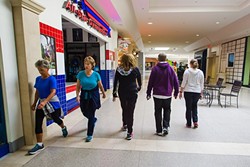
- PHOTO BY JAYSON MELLOM
- THE MALL WALKERS: While the Santa Maria Town Center includes several indoor exercise opportunities, like different gyms, many locals—including senior citizens—walk the mall’s interior halls for activity.
His name is Hans Reithofer, and he’s sitting alone on one side of a big chessboard, ready with pieces in starting position. The large, wood carved pieces excite the attention of kids and adults alike—Reithofer is always ready for a game no matter the player’s level of experience.
Chess stimulates the mind, Reithofer explained, and provides an opportunity to socialize with different people or repeat opponents. (Full disclosure: This writer is one of Reithofer’s regular chess partners.) But more than anything, he said, chess is something he enjoys that gets him out of the house each day.
“I don’t know why, but I can size up a chess game in about 10 seconds,” he said.
But queen sacrifices and checkmates aren’t the first things to get Reithofer out of the house—tennis is. He has played tennis continuously throughout his adult life, Reithofer explained, and can be found several days of the week playing at the Minami Park courts, which are free to use.
The sport is low impact, but anaerobic (walking is considered to be aerobic activity) because it’s playing with shorter, faster bursts of movement. Reithofer—who was diagnosed with Parkinson’s Disease when he was 40—credits his current quality of life to his tennis playing.
“I think it has helped a great deal,” he said. “I love doing it, and it helps me. For having Parkinson’s for 22 years, I’m doing incredibly well. The doctor is impressed.”
Reithofer has had Parkinson’s for two decades, but doesn’t require a cane or a walker to get around. That isn’t normal for someone of his age and ailment, he said.
- GET OUT THERE : Minami Park includes a recreation center, playground, fields, courts, and a bocce ball court at 600 W. Enos Drive, Santa Maria. More info: 925-0951 or cityofsantamaria.org.
But staying active with tennis has as much to do with his mindset as it does with anything else, he explained.
“It’s my stubbornness to keep exercising,” Reithofer said. “A disease is horrible. It kind of takes your willpower and your getup-and-go and all your enthusiasm. So, I just refuse to cave in.”
What Reithofer and the Clydes have in common is simple: using their legs. While tennis involves plenty of arm movement, the key is being nimble on your feet. And if you tried to keep up with the Clydes on one of their walks through the mall, you’d be surprised at the pace they maintain, even without considering they are both in their 80s.
Many seniors do have hip and leg troubles, so walking can be challenging for them. But walking consistently is one of the surest ways to keep your legs strong, according to Allan Hancock College anthropology professor Brian Stokes.
It all goes back to our ancestors, Stokes explained, and their unique mode of locomotion—walking on two limbs instead of four.
“[Bipedalism] is a big deal for Hominids in general, that’s pretty much the main impetus that drove us to where we are today,” Stokes said. “That’s what separated us from the common ancestor with the chimpanzees and such.”
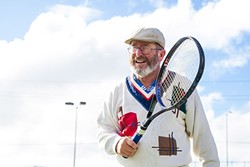
- PHOTO BY JAYSON MELLOM
- GET OUT AND MOVE: Senior citizen Hans Reithofer spends several days a week playing tennis at the Minami Park tennis courts in Santa Maria, which are free for anyone to use.
Bipedalism was a game changer for our proto hominid ancestors, Stokes explained. We’re the only ape with a striding gait, he said, which means our femur can extend behind the body as well as in front.
This allows a more efficient mode of transportation than walking on all fours, he said, utilizing fewer calories for the same distance traveled. Because of this biological adaptation, humans can walk for hours on end without rest.
The regular usage of the muscles and bones, especially into old age, is what keeps them strong, Stokes explained, but especially for the bones. When muscles pull on bones, the bones are strengthened, he said. That’s why a lifetime of physical activity, like walking, can help ensure strong hipbones, even later in life.
“Virtually any exercise is going to be good for you, and the more you do, the more you’re going to build muscle mass and the stronger your bones are going to be,” Stokes said. “And if you want to take it to the next level, that’s where a lot of people are looking at certain diseases that we have in our society today that weren’t very common in the past, like osteoporosis and certain types of cancers.
“These are diseases that are a byproduct of our Western culture as far as being sedentary, not being active, and overindulging in food and drink that in the past they wouldn’t do, they wouldn’t have access to those resources,” he added. “Those are known as diseases of development.”
Moving every day, especially walking, is the closest we can get to the lifestyle of our ancestors—arguably what we’re adapted to do.
While the Clydes and their fellow mall walkers may not know the hard science, they know firsthand what a daily walk does for them. It’s the reason they can be found there most days, pacing under the skylights and balconies of the Town Center.
“We are physically fit. We have some health issues, but we know we’re alive still because we stay physically fit,” Arlene said. “Walking is a good way to do it. It’s not quite as easy on the body as swimming would be, but we’re not swimmers, we’re walkers. We just love it.”
Contact Joe Payne, interim managing editor of New Times’ sister paper to the south, at [email protected].
Comments